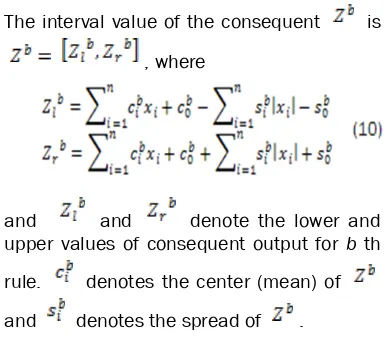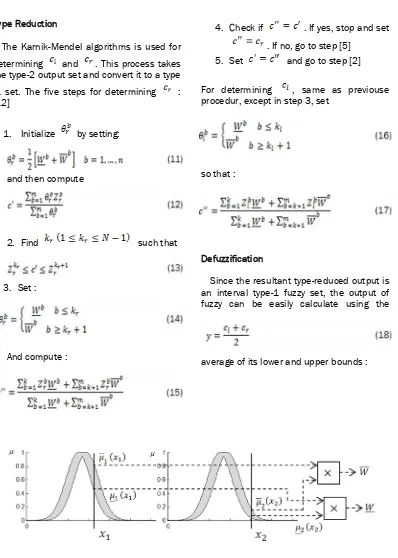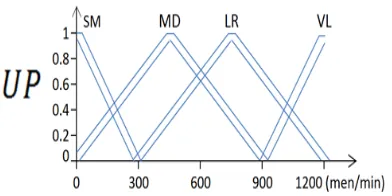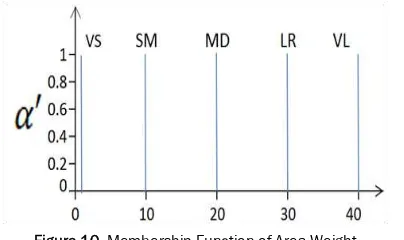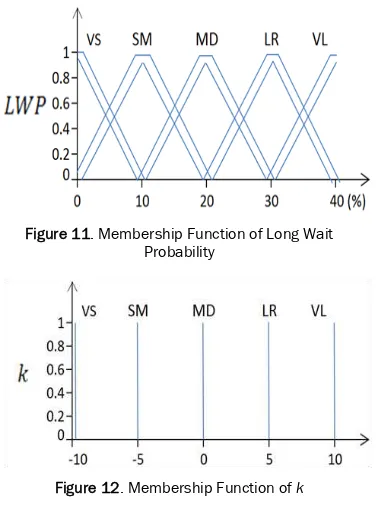DESIGN OF AN ELEVATOR GROUP CONTROLLER
USING TYPE-2 FUZZY LOGIC
MUHAMMAD ARIA
Department of Electrical Engineering Engineering and Computer Science Faculty
Universitas Komputer Indonesia
The elevator group control systems are the control systems that manage systematically two or more elevators in order to efficiently transport the passengers. In the elevator group control system, the area-weight which determines the load biases of elevators is a control parameter closely related to the system performance. This paper proposes a type-2 fuzzy model to determine the area-weight. The proposed method uses a two-stage fuzzy inference model which is built by the study of expert knowledge. A software has been developed to simulate the traffic flow of three elevator cars in a 15-floor building. The software simulates the movements of the cars as found in practical elevator systems. This simulation software was used to facilitate the evaluation of the proposed Type 2 Fuzzy System strategy. The software allows simulation of
different passenger’s traffic situations. The Type 2 Fuzzy Logic System is
compared with Type 1 Fuzzy System. The simulation results show that the Type 2 Fuzzy Logic Controller has better performance in the case of heavy traffic conditions. Type-2 Fuzzy Logic Controller reduced the average waiting time by 7
– 20 % and the long wait probability by 11 – 30 %.
Index Terms –Area weight, Average Waiting Time, Interval Type 2 Fuzzy System, Long Wait Probability, Karnik-Mendel algorithms
I. INTRODUCTION
Buildings with thirty floors or more are now a common sight in many cities around the world. So the demand for more efficient vertical transportation is rapidly increasing. The installation of multiple elevator is one of the nice solutions to cope with these trends. The elevator group control system, as shown in Figure 1, is a control system that manages systematically three or more elevators in a group to increase the service for passengers and reduces the cost such
as power consumption. Figure 1. Elevator Group Control Problem bidang
Most of the elevator group control systems have used the hall call assignment method which assigns elevators in response
to a passenger’s call. In this case, the
elevator group control system considers the current situation of a building to select the most appropriate elevator.The hall call assignment method assigns a new hall call to the elevator having the smallest evaluation function value among all the elevators. The area-weight is a parameter which affects the evaluation-function value of the elevators in the area close to the hall call.
There have been many researches in this area utilizing numerous approaches in designing the most effective elevator supervisory controller. Various strategy based on fuzzy logic system have been
studied to control the elevator group. C. B. Kim [1] proposed a fuzzy model to determine the area-weight. In another work, C.B. Kim proposed a control strategy generation method and fuzzy elevator group control system (FEGCS) in [2]. The control strategy of FEGCS is made using the classification of the passenger traffic and
system manager’s requirements, and the
hall calls are assigned to suitable elevators by generated control strategy. In [3], R. Gudwin introduced a fuzzy group supervisory controller with context adaptation to accommodate different traffic patterns.
This paper explores the use of Type 2 Fuzzy system, which is well known for its powerful in handling an uncertainties [4], to determine the area-weight parameter. Although there are a lot of work on type 2
Fuzzy as discussed in [5] – [7], as far as the author concerns, there is no work on development of type-2 Fuzzy is suitable for elevator group control. Contribution of this paper is to propose type-2 fuzzy algorithm suitable for elevator group control and compare the performance between the interval type 2 Fuzzy and type 1 Fuzzy.
The paper is arranged as follows. Type-2 Liang allowing the characterization of a type-2 fuzzy set with a superior membership function and an inferior membership function; these two functions can be represented each one by a type-1 fuzzy set membership function. The interval between these two functions represent the footprint of uncertainty (FOU), which is used to characterize a type-2 fuzzy set. Type-2 fuzzy sets allow us to handle linguistic
is another special case of Model I and we call it Model III.
We use Model I to design interval type-2 TSK Fuzzy system in this paper. A schematic diagram of the proposed T2TSK structure is shown in Figure 2., which is organized into i input variables and m rules.
Rule Base
In a first-order type-2 TSK Model I with a rule base of m rules and n input variables, is denoted as
where and . The
consequent parameter
, which are type-1 fuzzy sets, has interval, is denoted as
T h e m e m b e r s h i p g r a d e s
are interval sets to, which denoted as
Where is lower membership function
and is upper membership function. These rules let us simultaneously account for uncertainty about antecedent membership functions and consequent parameter values.
Fuzzification
are interval type-2 fuzzy systems described by Gaussian primary membership function with uncertain means, denoted as
Figure 3. Gaussian interval type-2 fuzzy membership function with uncertain means
where is the uncertain mean, with a = (1,…,n) is the number of antecedent, b = (1,…,m) is the number of
rules and is the standard deviation.
There are two kinds of type-2 sets. First is a gaussian type-2 fuzzy set, which the membership grade of every domain point is a Gaussian type-1 set contained in [0,1]. Second is an interval type-2 fuzzy set which the membership grade of every domain point is a crisp set whose domian is some interval contained in [0,1]. Figure 3. shows gaussian interval type-2 fuzzy membership function with uncertain means
The upper membership function is defind as
where
And lower membership function is defind as
Fuzzy Inference System
Fuzzy inference mechanism applies the fuzzy reasoning on the rules in the rule base in order to derive a mathematically reasonable output or conclusion which represents the problem conditions best. Fuzzy inferences in antecedent using algebraic product, is denoted as
and
Figure 4. shows Fuzzy inference illustrative example of the simplified case with two input variable.
The interval value of the consequent is
, where
and and denote the lower and upper values of consequent output for b th
rule. denotes the center (mean) of
Type Reduction
The Karnik-Mendel algorithms is used for
determining and . This process takes the type-2 output set and convert it to a type
-1 set. The five steps for determining : [12]
1. Initialize by setting:
and then compute
2. Find such that
3. Set :
And compute :
4. Check if . If yes, stop and set
. If no, go to step [5]
5. Set and go to step [2]
For determining , same as previouse procedur, except in step 3, set
so that :
Defuzzification
Since the resultant type-reduced output is an interval type-1 fuzzy set, the output of fuzzy can be easily calculate using the
average of its lower and upper bounds :
III. ELEVATOR GROUP CONTROL SYSTEM
The Elevator Group Control System
In the elevator group control system, provide service to every floor in a building, to minimize the time spent by passengers waiting for service, to minimize the time spent by passengers to move from one floor to another, to serve as many passengers as possible in a given time and to minimize the power consumption. The selection method is called the hall call assignment method. In assigned to the hall call decreases.
is called the area value and
the area weight, where is higher when the generated hall call is nearer to the floors where -th elevator is going to stop.
The value of is subtracted to adjust the usage of energy saving effect and represents the extent of the adjustment.
is the elevator’s status value. This value is added to prevent selecting the -th elevator if there exists a special kind of call (VIP call) or the elevator is not running.
The Area-Weight
If elevator is going to floor , the area of elevator for floor is defined. When a hall call happens in this area, our fundamental strategy is to select elevator for the call. The area represents the range of floors which can be served easily by that elevator. The area-weight is the value to increase the assignment probability for an elevator which is going toward the floor where a hall call was generated.
area value is defined for the floors where a call (hall and car) has happened.
Figure 5. Example of the area value
We can see that is a fixed value
and are estimated values.
However, the value is calculated whenever a call is generated. Therefore the determination of the value is important in the hall call assignment method.
If the value is big, the possibility that the elevator close to the relevant floor can be selected is increased. Consequently, the transportation load may be assigned to a specific elevator which is in the area. Furthermore, the average waiting time increases and the total running frequency of elevator decreases. Therefore the power consumption is reduced. If is small, the average waiting time decreases and the running frequency increases.
The predefined area-weight is usually used and it is defined according to the
traffic modes classified by the passenger’s
traffic pattern. In this study, we use the fuzzy approach to model the uncertain situation of the system and to determine the area-weight.
IV. A TYPE-2 FUZZY MODEL TO
DETERMINE THE AREA-WEIGHT
The type-2 fuzzy model is used to determine the area-weight. Fuzzy knowledge is generally formulated in the form of rules.
Fuzzy Rules
We classify the facts related with the determination of area-weight into two groups. The first group includes the up-going and down-going traffic amount named as pre-area fuzzy. The second group includes the average waiting time, long wait probability and power consumption named as area fuzzy.
The passenger’s traffic varies from hour to
hour and we can see that it is classified into some basic patterns.
up-peak pattern
This pattern is the case of which the up-going traffic is very large but the down-going traffic is very small.
down-peak pattern
In this pattern, the down-going traffic is much more than the up-going traffic normal pattern
The case of which both up-going and down-going traffic are approximately equal.
Figure 7. Membership Function of Down-Peak Traffic
Figure 10. Membership Function of Area Weight
The membership functions of the variables for the pre-area fuzzy rules are given in Figure 6 – Figure 8. Because there are only two input variables in this case, the complete rule base can be documented in matrix form, as shows in Table 1. Each combination of a column and a row describes a certain TRAFIC situation. The conclusion is given by the term at the intersection of the column and row.
Let AWT be the average waiting time, PC be the power consumption and LWP be the long wait probability. We introduce an adjustment value which represents the influence of the second group factors. This adjustment value will be added to the
area-weight and give new area-weight
(that is, ). The membership functions of the variables for the pre-area fuzzy rules are given in Figure 9 – Figure 12. Then we can represent fuzzy rules as Table 2.
Table 1. Pre-Area Fuzzy Rule
Figure 9. Membership Function of Average Waiting Time
Figure 10. Membership Function of Power Consumption
Up Peak Traffic
SM MD LR VL
Down
Peak
Traffic
SM MD LR VS VS
MD SM MD LR VS
LR SM SM MD LR
Figure 11. Membership Function of Long Wait Probability
Figure 12. Membership Function of k
Table 2. Area Fuzzy Rules
Fuzzy Model
We propose a fuzzy model to determine the area-weight through a two step fuzzy inference. Two step inference mechanism
improves the system’s stability from external
accidents and reduces the complexity of the system. Figure 13 shows the two step fuzzy inference mechanism.
Figure 13. The Fuzzy model to determine the area-weight
In step 1 of the fuzzy inference engine, the predetermined area-weight ( ) is calculated using the up-going (UP) and down -going (DN) traffic. In step 2, the adjustment value is determined through the fuzzy inference mechanism using the average waiting time (AWT), the long wait probability (LWP) and the power consumption values (PC). This value is added to the predetermined area-weight.
V. SIMULATION RESULTS AND DISCUSSION
Performance of Type 2 Fuzzy Controller is investigated using simulation studies. The developed controller was compared with Type-1 Fuzzy Controller. The condition of simulation are shown in the Table 3. According to the traffic pattern, the simulation situation is divided into several periods such as before lunch time (12:00 – 12:40), after lunch time (12:40 – 13:20) and common time (13:20 – 15:00). The evaluation criteria is the means of the average waiting time (AWT), power consumptions (PC) and average long wait probabilities (LWP). In the simulation, the Inference Rules Weight
If AWT is VL Then k is NL 1
If AWT is LR Then k is NM 1
If AWT is MD Then k is PM 1
If AWT is SM Then k is PL 1
If AWT is MD Then k is ZE 1
If PC is VL Then k is PL 1
If PC is LR Then k is PM 1
If PC is MD Then k is NM 1
If PC is SM Then k is NL 1
If PC is MD Then k is ZE 1
If LPW is VL Then k is NL 1
If LPW is LR Then k is NM 1
If LPW is MD Then k is PM 1
If LPW is SM Then k is PL 1
number of elevator runs is interpreted as the power consumption for that elevator. The average waiting time is measured in seconds and the long wait probability is in percent (%).
The Figure 14 and Figure 15 below show the traffic profile for down-peak traffic and up-peak traffic. The simulation results represented by these evaluation criteria are shown in Table 4.
Table 3 The Condition of Simulation
Figure 14. Profile for down-peak traffic
Figure 15. Profile for up-peak traffic
Number of floors 15
Number of elevators 3 Elevator capacity 20 man Simulation time 12:00 – 15:00 Time to open the door 1 seconds Time to close the door 1 seconds Time for each
passenger to get in
1 seconds
Time the door remains open
2 seconds
Type-1 Fuzzy Type-2 Fuzzy Improvement
(%)
Before lunch AWT 30.3 26.3 13.3
12:00 – 12:40 PC 48.0 52.8 -10
LWP 7.7 6.1 20.5
After lunch AWT 36.9 29.5 20
12:40 – 13:20 PC 46.0 52 -13
LWP 12.9 10.3 20
Common time AWT 32.7 34.9 -6.7
13:20 – 15:00 PC 51 48.6 4.7
LWP 10.2 10.7 -4.7
Total AWT 33.3 30.2 9.2
12:00 – 15:00 PC 48.3 51.1 -5.8
LWP 10.3 9.0 12.0
As shown in Table 4, in the case of normal comparison in the total period from 12:00 to 15:00 shows that the average waiting time
In this study the type-2 fuzzy was used to determine the area-weight which is one of
“Design and Implementation of a Fuzzy Elevator Group Control System”, IEEE Transactions of Systems, Man and Cybernetics – Part A: Systems and Humans, (May 1998), Vol. 28, No. 3, pp 288-298
R. R. Gudwin, F.A.C. Gomide, “Context
Adaptation in Fuzzy Processing”, Proceedings on the Brazil-Japan Joint Symposium on Fuzzy Systems, Campinas, Sp, Barzil (July 1994), pp. 15
– 20
Jerry M. Mendel, Type-2 “Fuzzy Sets and
Systems : An Overview”, IEEE
Computational Intelligence Magazine, (2007), vol 2, no.1, pp. 20-29
Ching-Hung Lee, Yu-Ching Lin, and Wei-Yu
Lai, “Systems Identification Using Type-2 Fuzzy Neural Network (Type-Type-2 FNN)
Systems”, Proceedings IEEE
International Symposium on
Computational Intelligence in Robotics and Automation, (2003)
Oscar Castillo and Patricia Melin, “Adaptive
Noise Cancellation Using Type-2 Fuzzy
Logic and Neural Networks”, Proc. of Fuzzy 2004, IEEE press, (2004)
S. Coupland, M. Gongora, R.I.John, K.Wills,
“A Comparative Study of Fuzzy Logic
Controllers for Autonomous Robots”
A. Fujino, T. Tobita and K. Segawa, “An Elevator Group Control System with Floor-Attribute Control Method and System Optimization Using Genetic
Algorithms”, IEEE Transactions on Industrial Electronics, (Augusts 1998), Vol. 44, No.4.
T. Walczak, P. Cichosz, “A Distributed Learning Control System for Elevator
Groups”, Proceedings of 8th International Conference of Artificial Intelligence and Soft Computing, Zakopane, Poland (2006), pp. 1223 – 1232
T. Tyni, J, Tlinen, “Evolutionary Bi-objective Controlled Elevator Group Regulates passenger Service Level and Minimises
Problem Solving from Nature, Birmingham, Uk, (2004), pp. 822 - 831
Qilian Liang and Jerry M. Mendel (1999), An Introduction to Type-2 TSK Fuzzy Logic
Systems, IEEE International Fuzzy
Systems Conference Proceedings, pp III-1534 – III-1539.
Jerry M. Mendel and Hongwei Wu (2007), New Results About the Centroid of An Interval Type-2 Fuzzy Set, Including the Centroid of a Fuzzy Granule, Information Sciences an International Journal, pp 360 – 377.
T. Beielstein, C. P. Ewald, S. Markon,
“Optimal Elevator Group Control by

